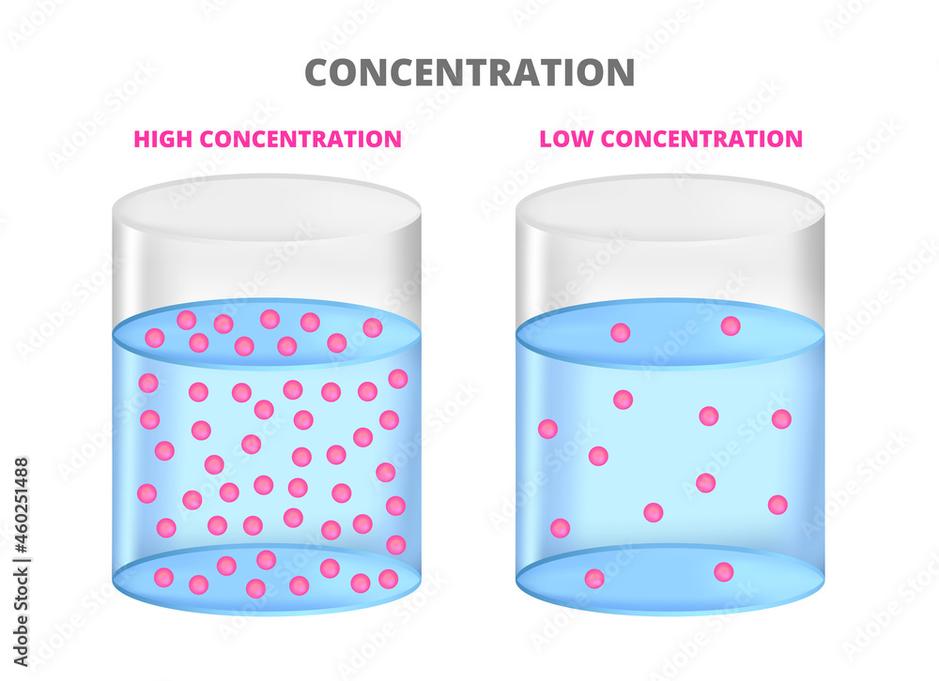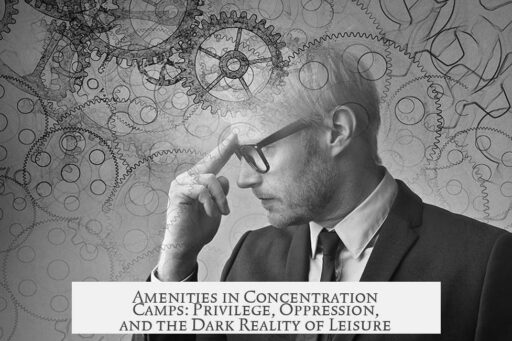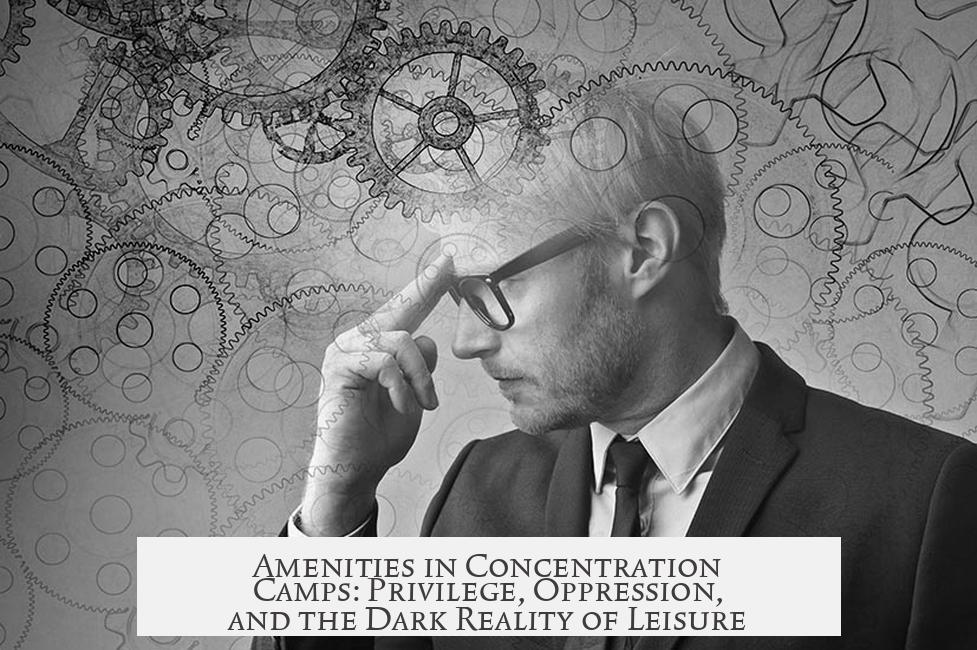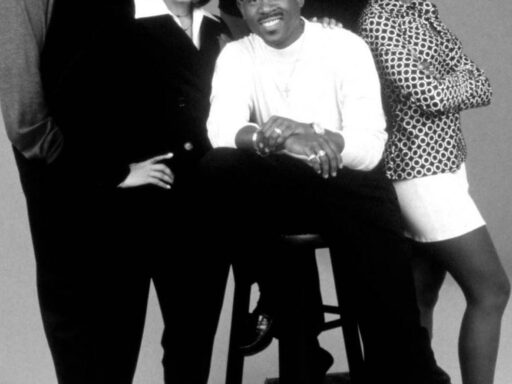Concentration camps did have amenities such as soccer fields, swimming pools, orchestras, daycares, and libraries, but these facilities were not meant for prisoners’ well-being. Instead, they served the SS guards, their families, and select privileged prisoners as tools to maintain control and complicity within the camp system.

Facilities like swimming pools existed in Auschwitz I Stammlager, but they primarily functioned as a water reservoir initially for firefighting purposes. Although diving boards were later added, access to the pool was strictly limited to SS personnel and certain favored Aryan inmate-functionaries. Prisoners, especially Jewish inmates, were excluded from such privileges.
Similarly, soccer fields were present in several camps, including Auschwitz and Mauthausen. In some cases, the camp authorities organized soccer tournaments between SS guards and prisoner teams. Yet even in these forced recreational activities, threats of violence loomed. At Mauthausen, prisoner teams winning matches were sometimes executed afterward, illustrating the brutal manipulation underlying these events.

Orchestras also formed part of the camp environment. Playing in the orchestra granted prisoners privileges like better clothing and food rations. However, this position was perilous; for example, in Auschwitz, camp commandant Rudolf Höss ordered half the orchestra members killed because he disliked their rendition of his favorite marches. This reflects that privileges were fragile and subject to arbitrary cruelty.
Daycares and libraries existed primarily to support the SS personnel and their families living on or near the camp grounds. In Auschwitz, there was a daycare for the children of SS personnel. Libraries offered leisure for the guards, mirroring amenities found in ordinary workplaces. These facilities aimed to create a “normal” life environment for the perpetrators amidst the industrial mass murder taking place simultaneously.

It is critical to emphasize how the Nazis used these amenities as part of a calculated strategy. SS members working in extermination camps had to endure the psychological strain of their roles. These leisure facilities helped keep them comfortable, motivated, and loyal—tools for maintaining the machinery of oppression and genocide. Amenities also reinforced the internal hierarchy among prisoners. Certain “privileged” inmates, serving as kapos or camp functionaries, received small rewards, such as access to the pool or orchestra, in exchange for complicity in camp administration.
Holocaust denial arguments often misuse the existence of these amenities. For instance, some claim the Auschwitz pool proves the camp was not a site of extermination. This misinterpretation ignores that the pool was off-limits to victims and served guards exclusively. Additionally, it originally functioned as a firefighting reservoir, not a recreational facility. Such select facts do not invalidate overwhelming evidence of systematic mass murder.

Photos and testimonies reinforce this understanding. Images show SS guards at leisure, celebrating or resting, often using prisoner labor for domestic tasks. Diaries and letters from camp personnel describe the comfortable living conditions they enjoyed despite the surrounding horror, confirming that daily life for the perpetrators and their families sharply contrasted with that of the prisoners.
Ultimately, these amenities illustrate the grim social dynamics within concentration camps. They highlight the division between victim and oppressor, the use of privilege as a control mechanism, and the brutal normalcy with which perpetrators conducted genocide. Recognizing this complexity is crucial when examining the function and meaning of such facilities within the camp system.

- Swimming pools and soccer fields existed but served SS personnel and favored prisoners, not the majority of inmates.
- Orchestras provided relative privilege but involved constant danger and did not ensure safety.
- Daycares and libraries supported SS families living near camps, not prisoners.
- Amenities were tools to maintain morale and complicity among perpetrators and select prisoners.
- Holocaust deniers misuse these facts, ignoring the broader context of genocide.
Did Concentration Camps Have Soccer Fields, Swimming Pools, Orchestras, Daycares, and Libraries?
Yes, concentration camps like Auschwitz had amenities such as soccer fields, swimming pools, orchestras, daycares, and libraries, but these were not for prisoners’ comfort—they served the SS guards, privileged inmates, and functioned as tools of control and oppression. Let’s unpack this complex reality with careful detail and context.
The mere mention of swimming pools and soccer fields inside Nazi concentration camps can sound bizarre—almost surreal. These places are infamous as sites of mass murder and unimaginable suffering. How could they also host leisure spots? The answer lies in understanding who these amenities were for, why they existed, and how they fit into the horrific system of the camps.
Swimming Pools and Soccer Fields: Privilege, Not Comfort for Victims
Auschwitz I (the main camp or Stammlager) contained a swimming pool. But before you picture rows of emaciated prisoners taking a dip, know this: the pool was originally built as a water reservoir for firefighting. The diving boards were added later—not for leisure, but as extravagance for the SS men and select Aryan prisoner-functionaries, those camp inmates who collaborated or served the SS.1
Similarly, around the camp complex, there was a soccer field. In Mauthausen, SS guards and prisoner teams even competed in soccer tournaments. Horrifyingly, the prisoners who won were often killed afterward.2 Sports were not carefree fun, but psychological tools. Prisoners who privileged these “rewards” were indirectly complicit in their own subjugation.
Orchestras: Music Beneath Death’s Shadow
Few imagine orchestras inside death camps. But they existed. Playing music brought better food and clothes, a rare slice of privilege in an otherwise brutal environment.3 Yet safety was never guaranteed. For instance, Auschwitz’s commander Rudolf Höss had half the orchestra members killed because he disliked their marching tunes.3
Music was not entertainment; it was exploitation. Prisoners forced to play music marched others to their deaths or performed during executions, adding surreal horror to the experience. Privilege in the orchestra was a double-edged sword, offering a brief respite but never protection.
Daycares and Libraries: For Whom Were These Built?
Perhaps most startling is the fact that Auschwitz had a daycare center—but it was exclusively for the children of SS personnel, not prisoners.4 The SS guards lived in houses onsite with their families nearby. For these merciless perpetrators, life continued “normally” after the day’s atrocities—family meals, childcare, reading books from camp libraries.5
The library likewise catered to the SS guards—the administrators, not the inmates. This fact is crucial for understanding the Nazis’ system: camps were workplaces with routines and amenities aimed at keeping the perpetrators content and productive.
The Purpose Behind These Amenities: Comfort for Killers, Tools for Oppression
Why build pools, libraries, and daycares inside death camps? Simple: to stabilize and maintain the system. SS guards and functionaries needed breaks from the brutal work of mass murder. Nazis were employer-like in this regard, ensuring workers had incentives like leisure spots.5
Prisoners, meanwhile, were divided into strict hierarchies. Some non-Jewish, often German prisoners were given “privileges” like swimming rights or orchestra spots to enforce control and encourage compliance.6 This division created deadly rivalries and broke down solidarity among captives—an intentional strategy to reinforce captivity.
Does the Presence of Such Amenities Negate the Reality of the Holocaust?
Not in the slightest.
Some Holocaust deniers cherry-pick facts like the Auschwitz swimming pool to claim the camps were “benign.” This is a profound distortion of history.
The pool was a fire reservoir, off-limits to prisoners, designed to serve the SS. The occasional enjoyment of a swim by guards doesn’t rewrite the fact that Auschwitz was simultaneously an industrialized death factory.7
Murderers do not cease being murderers because they read books, listen to music, or enjoy family life. The amenities served the murderers’ needs while millions of innocent people were exterminated nearby—this stark juxtaposition reveals the monstrous practical mind of the Nazi regime.
Social Dynamics Within Camps: Privilege and Peril
Inside the camps, especially Auschwitz I, there was an internal hierarchy: Jewish prisoners suffered the worst conditions and extermination, while some Aryan prisoners enjoyed limited privileges.8 This hierarchy was an administrative tool. Severe punishments and rare luxuries dangled like a carrot—swimming, playing soccer, or joining the orchestra could buy survival or status.
Yet, no privilege guaranteed safety. Orchestra members enjoyed better food but could be killed on a whim.3 Prisoners who won soccer games in Mauthausen were executed afterward.2 The system was designed to foster mistrust and despair.
Built By Prisoner Labor, Used by Oppressors
Every amenity was built using prisoner labor—forced to build swimming pools, soccer fields, daycares, and libraries.5 In other words, the victims’ own suffering created superficial comforts for their tormentors.
Imagine building a swimming pool for your captors while you starve and toil nearby. Cruel irony doesn’t capture the full horror.
First-Hand Testimonies and Photographic Evidence
Photographs exist showing SS guards enjoying parties, drinks, and leisure near these amenities.9 Diaries from camp personnel describe comfortable domestic lives, despite the constant stench of burning human flesh from mass executions.9
Some SS families lived on-site, with prisoners, sometimes female Jehovah’s Witnesses, serving as house personnel.9 This contrasts fatally with the prisoners’ daily reality—chained in brutal labor, facing extermination.
Why Does This Matter?
The existence of amenities in concentration camps reminds us that the Holocaust’s machinery was run by human beings—who juggled ordinary pleasures with unimaginable cruelty.
This fact underscores the brutal efficiency and cold calculation of the Nazi system. It challenges simplistic assumptions and demands nuanced understanding. Recognizing this complexity helps combat Holocaust denial and superficial interpretations.
In Conclusion: A Dark Practicality Behind Tats of Leisure
So yes, concentration camps had soccer fields, swimming pools, orchestras, daycares, and libraries—but only for the SS personnel and privileged functionaries, not the victims. These amenities were mere tools to maintain control, reward complicity, and create a facade of normalcy for the perpetrators of mass murder.
Leisure and horror coexisted chillingly here, revealing the depth of Nazi depravity. Understanding this helps us grasp the full scope of human cruelty, the social engineering behind genocide, and the importance of remembering history accurately and respectfully.
References for the Curious Reader:
- Swimming pools and soccer fields for SS and privileged prisoners in Auschwitz I
- Soccer tournaments in camps like Mauthausen with deadly consequences for winner prisoner teams
- Camp orchestras and their paradox of privilege and peril in Auschwitz
- Daycare for SS personnel’s children inside Auschwitz complex
- Use of prisoner labor to build amenities serving guards and their families
- Social hierarchy among prisoners to enforce Nazi control
- Holocaust deniers’ misuse of swimming pool facts to distort history
- Jewish prisoners’ suffering vs. privileged non-Jewish inmates
- Photographs and diaries showing SS guards’ leisure life with amenities
Remember, facts must be understood in context to prevent dangerous distortions. The swimming pool and the library don’t erase the horrors—they instead reveal the chilling reality of those who committed them.
Did concentration camps have swimming pools, and who used them?
Auschwitz I had a swimming pool used mainly by SS men and some privileged Aryan prisoners. It was originally built as a water reservoir for firefighting, not for recreation.
Were there soccer fields in the camps, and who played there?
Yes, camps like Auschwitz and Mauthausen had soccer fields. Matches sometimes involved SS guards and prisoner teams. However, prisoners who won were often punished severely.
Did orchestras exist in concentration camps, and what was their role?
Orchestras were formed by prisoners and offered better food and clothes. Yet, it was a risky privilege; camp leaders could punish musicians harshly for disobedience.
Were there amenities like daycares and libraries in concentration camps?
Facilities like daycare centers and libraries existed for SS personnel and their families, built using prisoner labor to keep guards comfortable and loyal.
Do these amenities mean camps were safe or humane?
No. Amenities served to support the SS and control prisoners. They did not improve conditions for most inmates or negate the existence of mass murder and oppression.




